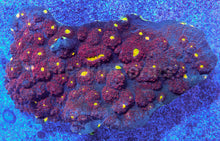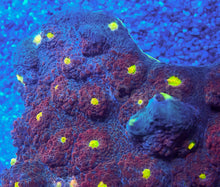✨ Solar Eclipse Chalice
Echinophyllia sp. (Purple Chalice with Ultra Yellow Eyes)
🔹 Quick Stats
-
Care Level: Moderate
-
Temperament: Semi-aggressive (sweeper tentacles at night)
-
Colour Form: Rich velvety purple base studded with ultra-bright, glowing yellow “eyes.” In colonies, the contrast between the deep background and neon centres creates a dramatic cosmic effect. Under actinic/blue light, the yellow pigments fluoresce intensely, transforming the coral into a radiant focal point.
-
Water Conditions: 24–27 °C, dKH 8–11, pH 8.0–8.4, sg 1.024–1.026
-
Family: Pectiniidae
-
Lighting: Moderate to high (for best coloration)
-
Supplements: Calcium, Magnesium, Trace Elements
-
Water Flow: Low to moderate, indirect
-
Placement: Mid to lower levels of the aquascape, away from aggressive neighbours
🧬 Overview
The Solar Eclipse Chalice is a spectacular collector’s coral, blending a dark royal purple base with luminous yellow eyes that pop like stars across its surface. As the colony grows, the pattern becomes more intense, with each eye glowing under reef lighting like miniature suns in a cosmic nebula. This rare colour morph is an “ultra” showpiece — perfect for aquarists who want a true centrepiece in their chalice collection.
🍽️ Feeding & Care
Chalices are photosynthetic but thrive with supplemental feeding 1–2 times per week. Offer small particulate foods such as rotifers, enriched brine, or micro-sized reef blends. Feeding at night, when feeding tentacles are extended, enhances growth rates, boosts colour intensity, and ensures long-term health.
📈 Optimal Parameters
-
Alkalinity (dKH): 8–11
-
Calcium (Ca): 420–460 ppm
-
Magnesium (Mg): 1250–1350 ppm
-
Nitrate (NO₃): 2–10 ppm
-
Phosphate (PO₄): 0.01–0.05 ppm
📍 Placement
Position in a stable area with moderate lighting to bring out the ultra-colour tones. Avoid direct high flow, which may damage tissue. Give plenty of space from other corals, as chalices can extend sweeper tentacles at night. Under blue-rich lighting, the neon eyes fluoresce like fireflies across the colony, making it a true “ultra” specimen.




